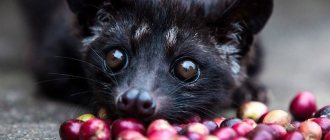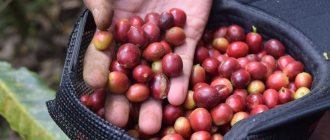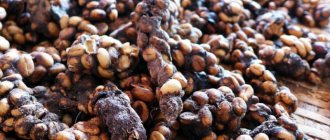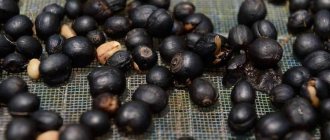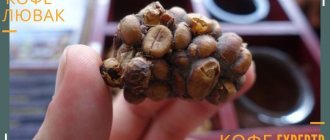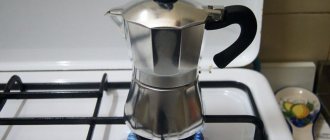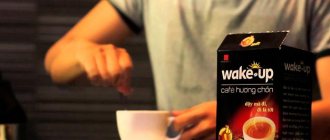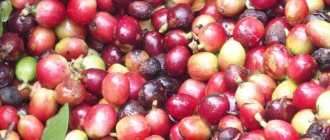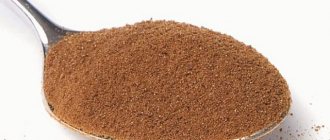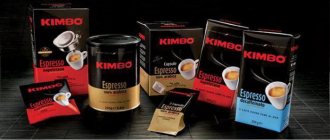History of the drink
Vietnam was a colony of France for a long time - from the 1880s to 1954. In 1857, Catholic missionaries brought the first coffee bushes to the country from the French island of Reunion. The colonists found it economically profitable to produce coffee for export. In 1908, new species were introduced into the country - robusta and liberica. In 1945, trees occupied an area of about 10 thousand hectares, and about 4,500 tons of product were produced annually. Most of the products were supplied to France.
The focus on the global market appeared after the creation of the Socialist Republic of Vietnam in 1976. The scale of coffee production doubled, and large state cooperatives emerged.
At the end of the 1970s. There is an active development of the Central Highlands (Tainguen) - a plateau in the south of the country: many coffee fields have appeared there. Since 1989, the integration of the Vietnamese economy into the world economy began, and by 2000, the coffee industry (compared to 1976) had grown 100 times.
In 2001, Vietnam joined the International Coffee Organization and the Association of Coffee Producing Countries. The country began to curb the production of low-quality raw materials in order to meet international standards. In 2009, the share of Vietnamese coffee amounted to 18% of global coffee production; Vietnam is second only to Brazil in terms of exports.
At the end of 2021, the World Coffee Museum was opened in Dak Lak province. Equipped in the style of the dwellings of the ethnic peoples of the Central Plateau, it recalls the time when new territories were being developed for plantations.
History of Vietnamese coffee
The founders of coffee plantations in Vietnam are rightfully considered to be French colonists, who brought the first coffee bushes here back in the 19th century.
A suitable climate and a large number of mountain slopes made it possible to quickly develop this industry and, within a few years, receive the first batches of grains for export.
Despite all the necessary conditions for obtaining grain, Vietnamese coffee was able to enter the international market and take a leading position in it only in 2007, when its exports amounted to 1 million tons of beans per year.
Today this is 15% of all grain grown in the world.
Vietnamese coffee provinces
The first fields appeared in 1888. They were located in Nghe An province. Then they started growing trees in the southern provinces - Thanh Hoa, Ha Tinh, and in the central ones - Quang Binh and Quang Tri.
Climatic conditions affected the taste and aroma of the product.
Vast fields - more than 600 thousand hectares - appeared in 1898 on the Teing Guen plateau, in the Central mountainous region. The optimal climate for growing coffee raw materials is in the vicinity of the city of Dalat (Lam Dong province), and the largest coffee shops are located in the city itself, which is called little Paris.
The main grain producer is Dak Lak province. Plantations covering an area of 506 thousand hectares produce an annual harvest of about 1 million tons. The administrative center of the province, Buon Ma Thuot, is considered the capital of coffee.
In modern Vietnam, plantations are located in almost every corner of the country. The plots are numerous and small: from 1 to 5 hectares, only 1% of all products are grown on plantations larger than 5 hectares.
World Coffee Museum in the coffee capital of Vietnam
The World Coffee Museum, part of the Coffee City project, was built by Trung Nguyen Legend Group and officially opened to visitors on November 23, 2021.
The World Coffee Museum especially attracts visitors with its unique architecture. It is a long house in the form of polymorphic and flexible curves intersecting with each other.
The museum houses more than 10,000 artifacts related to the three typical coffee civilizations of the world, going back almost three centuries. The museum also combines exhibition space, observation decks for coffee, and a library.
In addition, in keeping with the concept of a "living" museum, the World Coffee Museum hosts weekly community events and has hosted more than 60 cultural events since its inception, including specialized exhibitions on coffee, conservation, and indigenous culture.
In 2021, to continue the goal of becoming a center for coffee education to strengthen Buon Ma Thuot and Dak Lak's position in the world, a special exhibition "Warrior" was held.
Also this year they plan to hold a series of thematic exhibitions, such as “Coffee and Return to Origin”, “Coffee and Human Enlightenment”, “Coffee and Interference between East and West”. In addition, a series of short-term training programs in coffee techniques around the world, as well as long-term training courses in barista skills from basic to professional level or workshops.
World Coffee Museum, exterior
Characteristics of coffee
As a raw material, it is represented by 2 popular pure types:
- Arabica (accounts for about 14% of all products);
- robusta (85% of production).
Robusta is a strong variety that contains almost 3 times more caffeine than Arabica. It is inexpensive and therefore forms the basis of Vietnamese drinks. More expensive Arabica is the basis for elite varieties or is added to Robusta to give a delicate flavor.
Robusta forms the basis of Vietnamese drinks.
Vietnamese coffee is exported in ground, instant and bean forms. In Russia, ground and instant products are still rare.
Taste characteristics
The drink has a rich taste and strong pleasant aroma, and is less bitter than Brazilian or Indonesian coffee. May have the following flavors:
- chocolate;
- vanilla;
- caramel;
- cream;
- nuts.
These characteristics depend on the characteristics of the variety, production, roasting and the ratio of Arabica to Robusta.
Beneficial features
The chemical composition of coffee has a beneficial effect on the human body:
- caffeine - reduces fatigue, increases productivity, speeds up metabolism;
- vitamin P - strengthens capillaries;
- antioxidants - prevent the aging of the body, reduce the risk of developing cancer;
- chlorogenic acid - normalizes the functioning of the gastrointestinal tract;
- trigonelline - prevents the development of atherosclerosis;
- nicotinic acid - lowers cholesterol levels;
- polysaccharides - increase brain activity;
- tannins - improve digestion.
Coffee reduces fatigue and increases productivity.
In addition, coffee:
- stimulates the functioning of internal organs and mental activity, so its moderate consumption is the prevention of Alzheimer’s and Parkinson’s diseases;
- eliminates migraine;
- is an antidepressant;
- has an antiallergic effect, because reduces the level of histamines;
- helps with intoxication of the body with drugs or poisons.
Despite the extensive list of beneficial properties of the product, it is not recommended to exceed the daily norm of the drink - 3-4 cups of 240 ml.
Vietnam Coffee Production Forecast 2021
Coffee production in Vietnam is forecast to increase by 1.1 million bags in 2021 to reach a record 30.4 million.
Because cooler weather and off-season rains have helped stimulate coffee trees just before flowering and planting.
Some areas experienced heavy rainfall during the flowering period, raising concerns that yields would be lower than initial estimates. However, the additional rain resulted in an increase in cherry blossoms, which more than compensated for some areas where rain damaged the flowers.
Last year's large harvest offset low prices, allowing farmers to buy adequate inputs for this year's harvest and improve yields.
Planted area is forecast to increase slightly compared to last year, with nearly 95 percent of total production remaining as robusta. Exports, domestic consumption and ending stocks are expected to rise due to an increase in available stocks.
Vietnam plantations Post Views: 733
Production Features
Peasants prefer to plant coffee trees next to fruit trees or just tall plants that bring additional income, such as corn.
Coffee trees are planted next to fruit trees.
In the natural shade, the berries ripen longer and absorb more nutrients, which will later provide the drink with a rich taste.
Harvesting:
- Robusta - September-October. Ripe fruits can hang on a branch for a long time without falling off. This allows you to start harvesting when almost all the berries are ripe. Robusta is harvested using the stripping method - with a sliding movement of the hand, the fruits are peeled from the branch onto a canvas spread on the ground.
- Arabica - September-October. The fruits ripen unevenly; 2-3 approaches to one tree are required to collect the entire harvest. The method is called manual picking, i.e. Ripe berries are selectively collected, leaving the green ones to ripen.
Mechanized processing of collected berries is carried out only in a few large factories. Basically all work is done manually.
The technology is different:
- Dry or natural method. The fruits are scattered in a thin layer on a canvas or in a sieve and left to dry naturally for a week. Periodically stir with your hands or a spatula.
- Semi-moist method. The berries are dried a little, then the skin, pulp, gluten and patch are mechanically removed. Wash and dry.
- Wet. Allows you to obtain high quality products; it is often used when processing Arabica beans. When washing, the fruits are immersed in water and the floating unripe berries are removed. After treatment with a depulpator (like a grater, designed to separate the pulp from the peel), the grains are sent to dry.
The next step is fermentation to remove gluten. The grains are again immersed in water for 12-36 hours.
As a result of the action of bacteria, the gluten itself will begin to peel off. The grains are then dried and, after hulling (husking), manually sorted and either packaged or sent for roasting.
A small educational program
Let's start with what's so special about Luwak coffee and why is there so much buzz around it? And it’s all in the production process, so to speak. The fact is that this coffee is “made elite” by small predatory animals - musangs (they are also civets, they are also palm martens). In the wild, this animal eats the ripest coffee beans. It turned out that in the stomach of the musang, coffee beans are cleaned of all unnecessary things, saturated with a special enzyme, and the result is the most elite and expensive coffee beans in the world. Actually, the product of the coffee life of this little animal is collected, the beans are selected, washed, dried, fried and sold at a high price. Coffee gourmets claim that the coffee “produced” by musang is devoid of unpleasant bitterness and has a pleasant caramel flavor. In fact, their words are not without truth. Luwak coffee is really different from most varieties, only if you don't drink it as sweet as the Vietnamese do. Since with so much condensed milk, even tar and bitumen will be quite a tolerable delicacy.
Without proper processing, Luwak coffee does not look very presentable.
Many people wonder: What kind of perverted mind do you have to have to think of brewing cocoa in a Turk.... animal waste products? Indeed, someone thought of this. But if the history of Kopi Luwak does not lie, one farmer decided to make coffee “after the musangs”. It so happened that his entire harvest was destroyed by these same animals. In order not to go broke, the enterprising man collected what was left after the civet feast, washed it, fried it and packaged it in bags. As a result, the entire harvest was sold, and satisfied customers came for more. They really liked the new type of coffee.
Signature roast
The secret of the unique taste and smell of Vietnamese coffee is in roasting the beans along with cocoa beans. This method is used only within the country.
Signature roasting is the secret of the unique taste of coffee.
To give the product additional flavor shades, add:
- powdered milk;
- diluted condensed milk;
- fruit syrup;
- sugar;
- hazelnut or walnut oil.
Classic Vietnamese coffee is highly roasted; coconut oil is added to the cocoa beans.
What coffee to bring with you from Vietnam
Vietnamese coffee has a whole bouquet of flavors. These are the shades:
- hot chocolate;
- vanilla;
- milk;
- caramel;
- cocoa.
Traditional types of coffee are mixed together to make blends. As a result, new varieties are obtained. It’s difficult to say which coffee is the best in Vietnam. It all depends on your preferences.
Tourists bring Robusta home because of its affordable price. But the tart, earthy taste isn't to everyone's taste. Those who like a soft, less rich drink buy Arabica. In Vietnam, these two varieties are often mixed in a combination of 70% Robusta and 30% Arabica. This is the best value bean coffee.
The exotic Luwak is also popular. If you are not embarrassed by the method of its production and the high cost, it will be a wonderful and useful gift.
By the way, in Vietnam it is customary to roast grains heavily, which gives the finished drink a bitter taste.
Varietal varieties
In addition to Robusta and Arabica, there are also Liberica and Excelsa, but they are used very little. There are more than a hundred varieties.
Robusta
It is believed that Vietnamese robusta is more tasty and of higher quality than Asian or African. These are high-yielding and unpretentious trees. They prefer warm climates, but tolerate temperature changes well. Due to the high caffeine content (up to 2% per 100 ml of drink), the beans are rarely attacked by insects and therefore do not require mandatory chemical treatment. To soften the taste of the drink, robusta is mixed with Arabica in equal proportions.
Robusta is a bean containing large amounts of caffeine.
Arabica
The plant is whimsical; in case of unfavorable conditions, the yield is reduced. Plantings may require additional watering. Arabica coffee accounts for only 10% of all fields.
Without an admixture of Robusta it is almost never consumed. The drink has a slightly sour berry taste and a nutty aftertaste.
Excelleza (shari)
Another name is Excelsa. Trees are sensitive to weather conditions and produce crops irregularly. The spreading crown makes it difficult to collect fruits. Expensive grains are used to prepare elite blends. Shari contains a small amount of caffeine and gives the drink a distinct herbaceous flavor.
Excelleza is an elite variety that is usually used to create blends.
Coolie
Kuli is a rare and expensive drink made from selected Arabica and Robusta beans. It is produced only in Daklak. It is considered an excellent natural energy drink.
Katimor
A luxury mix of Arabica varieties Hibrido de Timor and Cattura, which is difficult to purchase even in Vietnam. The drink is valued for its fruity aftertaste.
Katimor is a hybrid of two coffee varieties.
Kopi Luwak
In Vietnam, Kopi Luwak coffee is called chon. To obtain it, whole ripe coffee fruits are fed to musangs (palm martens). Animals cannot digest grains, which, after undergoing fermentation in the digestive tract of the animals, are released with droppings. The raw materials obtained in this way lose the bitterness characteristic of coffee. Due to the labor-intensive and specific production method, the chon is the most expensive in the world.
The drink has a pronounced chocolate taste with a berry aftertaste. It is believed to have healing properties.
Blends
Mixtures of varieties, according to experts, are more refined than the pure variety. They are Robusta and Arabica in a percentage ratio of 60/40 or 70/30. Elite blends contain a certain percentage of other varieties, such as chon.
Blends are a mixture of Robusta and Arabica varieties.
Moka
Another name is mocha. It is prepared using Arabica beans and coconut oil is added during roasting. The drink contains little caffeine and has a delicate caramel taste.
Vietnamese coffee - what types and varieties are grown
Vietnamese Robusta
Currently, Vietnam supplies robusta to the world market, from which instant coffee and coffee blends are produced. Robusta is an extremely unpretentious type of coffee. Most of the robusta plantations are located at 500-600 meters above sea level. Abundance of moisture and sufficient average annual temperature are the main conditions for high yields. Such coffee trees easily tolerate high differences between day and night temperatures. In general, the cost of such coffee is low, which, coupled with sufficient demand for it, explains its wide distribution.
Many experts believe that Vietnamese Robusta is the highest quality representative of this variety. Comparing it with the products of other Asian and African manufacturers, one can note the large grains of Vietnamese coffee and a soft, mild taste. Of course, depending on the specific year and batch, the coffee parameters may vary somewhat, but if the consumer wants to experience sharper and richer flavor tones, then it makes more sense to try African varieties. The unique natural and climatic conditions of Vietnam make the taste of local robusta less sour than that of Africa, and the bitterness more smoothed out. This coffee exhibits nutty notes and hints of spice.
The Vietnamese Blue Dragon variety is characterized by notes of toasted bread, bitter cocoa and pistachios. The Blue Dragon grains are large and regular in shape. The density of the taste is average, and it manifests itself in an unusually delicate manner for Robusta. Another popular variety of Vietnamese robusta, Sang Tao, has maximum strength and a thick aroma, and a sweet note breaks through its bitterness. At the same time, this coffee cannot be called too “hard”, which is very often characteristic of Robusta.
Vietnamese Arabica
The Vietnamese produce very little Arabica beans. Only 5% of the total coffee harvest is of this type of coffee. But given the scale of the Vietnamese coffee industry, this is quite a lot (almost 50 thousand tons). For comparison, this is approximately the volume of coffee production in all of Costa Rica or half of the plantations in Nicaragua. Famous coffee hub Guatemala produces only 4 times more coffee than Vietnam's Arabica crop. The bulk of Arabica in Vietnam is grown in the same place as Robusta, in the Thai Nguyen region (Central Highlands). The provinces of Lam Dong, Kon Tum, Dak Lak, Gya Lai, and Dak Nong are located here.
But Arabica is a much more alpine species than Robusta. The areas of land planted with this coffee are located at an altitude of 1200-1600 meters above sea level. The plantations are located on slopes and terraces and require almost no artificial shading (for this, specially planted trees are used when growing other varieties). The Arabica varieties Catimor and Bourbon are predominantly cultivated. They were brought over by the French. Of all the Vietnamese Arabica varieties, the most common in Russia is “Vietnam Dalat” - high-quality and quite affordable coffee. “Vietnam Dalat” has a mild and balanced taste range. It contains bread and nut tones, pleasant berry sourness and a refreshing taste. This coffee can be prepared in any way, but it turns out especially well in a coffee machine.
Rare variety "Excelleza"
"Excelleza" (also called "High Coffee") refers to elite varieties. The production volume of this coffee is very small. The fact is that this coffee tree bears fruit irregularly, and it is impossible to plan supplies. Excelleza is mainly used in the preparation of mixtures. Its unusual aroma and taste allows you to give blends pleasant shades appreciated by coffee connoisseurs.
The famous Kopi Luwak
Kopi Luwak is one of the most expensive types of coffee. Its exotic taste is achieved by an equally exotic method of preparation. The bottom line is that the ripe fruits of the coffee tree are fed to small rodents - musangs. Their stomachs digest pulp, but not grains, which are fermented in a special way as they pass through the animals' bodies. During the brewing process, coffee is collected from rodent droppings, the beans are washed and dried in the sun. After this, such coffee starts to be very expensive.
Coffee "Kuli"
"Kuli" is a premium coffee produced in the province of Dak Lak (more specifically, in its capital Buon Ma Tuon). It is based on selected Arabica and Robusta, the grains of which were checked manually. Unfortunately, the supply volume of this variety is very small. Kuli coffee is characterized by a strong aroma and rich flavor. It leaves a pronounced long aftertaste and has a powerful tonic effect.
Famous brands
Coffee products are mainly produced on small farms. But there are also large companies whose products are known outside the country.
Me Trang
One of the best brands in the country. It emerged in 2000 and today unites a network of 19 branches. The company constantly improves product quality by modernizing processes. "Mechang" produces ground products, soluble and in grains. It has a large line of varieties (Chon, Robusta, Arabika, AR mixture), and supplies the market with recognizable red-brown packaging.
Me Trang is a high quality invigorating drink.
Con Soc
The products of this company can be easily recognized by the squirrel shown on the packaging. The company produces 2 varieties - Arabica (brown background on the packaging) and Blend (blue background). The raw material is grown on the Lam Dong plateau in Da Lat.
Distinctive features of production:
- When roasting beans, walnut oil is added, which removes bitterness from the drink and gives it a nutty flavor.
- Fine grind. It is better not to brew the powder in a classic press filter. The company itself recommends using paper filters.
Trang Nguyen
Vietnamese brand, popular all over the world. Exports products, including instant products, to 25 countries. The most popular product is an equal mixture of Arabica and Robusta Ocean Blue. Recognizable packaging with an image of an airplane or yacht.
Trang Nguen is the largest and most famous Vietnamese coffee producer.
Trang Nguyen includes subsidiary brands G7, Weasel kopi luwak, Passiona, Legendee and Creative.
Phuong Vy
Established in 1954, the company has its own plantations in Dak Nong and 2 factories that separately produce products for export and for the domestic market. Multi-stage processing of beans and complex caramel roasting give the product a signature taste.
Dong Phuong
A leading bean processing company, founded in 1995. The coffee of this premium brand is distinguished by high-quality roasting. Popular types are Espresso and Phoenix.
Dong Phuong is a coffee that is distinguished by high-quality roasting.
Tam Chau
A fast-growing company little known in Russia. Produces coffee and tea products for import and export. The plantations are located in Lam Dong.
Rozano
The company was founded in 2000. It produces ground and grain products from specially refined raw materials.
Rozano produces ground and grain products.
How has coffee impacted Vietnam's economy?
Around the world, when you think of coffee, you probably immediately think of Brazil, Colombia or, perhaps less commonly, Ethiopia.
But the second largest exporter in the world today is Vietnam. The country's market share has grown from 0.1% to 20% in just 30 years, and these rapid changes have impacted the country's economy.
Until the 1990s, there was little financial incentive for farmers to stop growing robusta because the Vietnamese government bought the entire coffee crop at a fixed price. With the opening of the private market, everything changed.
When the Vietnam War ended in 1975, the country was on its knees, and economic policies copied from the Soviet Union did not help. The collectivization of agriculture was a disaster, so in 1986 the Communist Party made a U-turn—betting big on coffee. Coffee production then grew by 20-30% every year in the 1990s.
Currently, the industry employs about 2.6 million people. Moreover, coffee beans are grown on half a million small farms ranging from two to three acres each.
This helped transform the Vietnamese economy. In 1994, about 60% of Vietnamese lived below the poverty line, now less than 10%.
Coffee was introduced to Vietnam by the French in the 19th century, and by 1950 the country already had an instant coffee factory in operation. This is how most Vietnamese coffee is consumed, which is partly why around a quarter of the coffee consumed in the UK comes from Vietnam.
Some companies, such as Nestle, have processing plants in Vietnam that roast the beans and package them.
But Thomas Kopple, an economist at the International Coffee Organization in London, says most are exported as green coffee and then processed elsewhere, such as Germany. While a large number of Vietnamese make a living from growing beans, some have become wealthy in the coffee business.
at the World Coffee Museum
Take, for example, multimillionaire Dang Le Nguyen Vu. His company, Trung Nguyen Corporation, renamed Trung Nguyen Legend Group in 2021, is based in Ho Chi Minh City, formerly Saigon. But its wealth is made in the Central Highlands around the town of Buon Ma Thuot, the country's coffee capital.
Chairman Wu, as he is nicknamed, owns five Bentleys and ten Ferraris and Forbes magazine estimates his wealth at $100 million. And this in a country where the average annual income is $1,300.
Dang Le Nguyen Vu
At the same time, some members of Vietnam's ethnic minorities say they have been driven off their land because of coffee farming.
But the multimillionaire says coffee is good for Vietnam. He plans to create an international chain of Vietnamese-style coffee shops.
“We want to introduce Vietnamese coffee culture to the whole world. It won't be easy, but we want to compete with big brands like Starbucks. If we can conquer the US market, we can conquer the world,” he says.
The museum stores more than 10,000 exhibits
However, expanding coffee fields also has its drawbacks. Agricultural activities of any kind pose hidden dangers in Vietnam due to the huge amount of unexploded ordnance left over from the Vietnam War.
In one province, Quang Tri, 83% of fields are believed to contain bombs. Environmentalists also warn that disaster is looming.
WWF estimates that 40,000 square miles of forest have been cleared since 1973, including for coffee farms, and experts say much of the land used for coffee cultivation is steadily depleted.
“Vietnamese farmers use too much water and fertilizer,” says Dr Dave D'Haze, a Belgian soil expert. “There is a traditional belief that you have to do this, and no one has been trained how to grow a coffee tree properly.”
Cooking instructions and recipes
Vietnamese coffee can be prepared in a coffee maker. It is rarely brewed in Turk, because the drink prepared in this way gives off bitterness. It is best to use the Vietnamese brewing method in a special brewing cup - a fin filter.
Preparation procedure:
- Place the teapot on the mug and pour coffee into it (from 2 to 4 tsp). Shake lightly so that the powder is distributed evenly at the bottom.
- Compact the top with a press. Do not tamp too hard, otherwise the liquid will not flow well into the mug. Pour a little boiling water to steam the grounds. Wait about 15 seconds.
- Pour boiling water to the edges of the fin filter or less, depending on the desired strength. Close the lid.
- The liquid will drip through the filter into the cup for about 4 minutes. When the process stops, the coffee is ready.
The infusion prepared in this way will serve as the basis for creating various drinks.
With ice
Place condensed milk and ice in a blender, pour in the prepared coffee and blend.
Iced coffee is a soft drink.
With rum
Add 1-2 tbsp to the finished robusta. l. Roma
With egg
Place a “cap” of eggs beaten with sugar or condensed milk on top of the coffee. First, eat the fluffy egg-sweet mass, then drink a hot or iced drink.
Coffee with egg is an unusual drink option.
With condensed milk
Place condensed milk to taste at the bottom of the cup. Place a fine filter on the cup and prepare coffee. The milk should dissolve on its own, without stirring.
With yogurt
Place 3 tsp in a cup. yogurt and pour unsweetened coffee.
Vietnamese coffee can be made with yogurt.
Smoothie
Fruit mixtures, such as avocado and banana, are mixed with the drink in arbitrary proportions.
How to brew Luwak correctly?
In many countries, coffee is brewed in Turks, and they also use modern coffee makers and coffee machines. These methods are not common in Vietnam.
Vietnamese teapots, condensed milk and ice.
Before trying Luwak, like any other variety, you must perform the following traditional ritual:
- You will need the so-called fin. This device is somewhat reminiscent of a mini drip teapot. It consists of a small metal cup with holes in the bottom, a round saucer also with holes, a kind of press and a lid.
- Place the flat saucer on the mug first, and then the glass itself.
- Pour a small amount of coffee into a glass. You need to leave room for water.
- Place a press on top, but you don’t need to press hard.
- Pour hot water, cover with a lid.
- Wait until the fragrant contents of the glass appear in the mug, drop by drop.
- Drink and enjoy!
Of course, you can brew coffee in a more conventional way, but to fully experience the magic of the Vietnamese drink, we recommend following local technology.
As we wrote above, in Vietnam coffee is traditionally served with ice, with condensed milk added if desired. Chilled green tea is also served along with it. These are the local traditions!
For a better taste experience, we recommend tasting without sugar. At least for starters. And most importantly, take your time, imagine that the moment has stopped! This is exactly what the Vietnamese do - they sit in a coffee shop for a long, long time, in absolutely no hurry.
The nuances of serving and drinking
Vietnamese coffee traditions have their own characteristics:
- The drink is served in glasses or special mugs.
- Coffee is not boiled, but brewed in a metal dropper cup with holes in the bottom.
- The default drink is as strong and sweet as possible. If you want it without sugar or condensed milk, you need to ask the barista about this in advance.
- It is not customary to serve cookies and other desserts with coffee, since drinks are almost always prepared with hearty additives, for example, condensed milk or egg.
What is the difference
There are three categories of coffee in Vietnam - high, medium and low grade.
- The first one is collected once per season. Such grains will ripen naturally in the sun. They do not stick when fried and do not need additives to improve the taste. The price of such real coffee is 300-500 thousand dong for 250 grams.
- The middle variety is harvested twice per season. It also lends itself well to frying. This type of coffee is the most common. The price is affordable: from 200 to 500 thousand dong per 500 grams.
- The lowest grade of coffee is harvested up to 6 times a year. The grain does not have time to ripen and is green. It takes a long time to fry it, it sticks and burns a lot, so they add oil. The grain becomes greasy, shiny and burnt. This type of coffee is the cheapest. Locals mostly drink it. When brewed it turns out fatty and bitter. This is where the Vietnamese tradition of drinking iced coffee and condensed milk came from. Condensed milk removes the bitterness of roasting, and thanks to ice, that same oily, greasy film is masked.
Places of sale and cost of coffee in Vietnam
It is better to buy coffee from well-known stores rather than from the market. The Me Trang and Crazy Shop chains of coffee shops and Big-C supermarkets enjoy a good reputation. Their prices are significantly lower than in Russian stores (see table).
| Ground coffee price | ||
| Name | Packing | Price, dong/rub. |
| Cafe Me Trang Arabica | 500 g | 58500/183 |
| Highland Coffee Culi | 200 g | 47000/147 |
| Trung Nguyen Nau Suc Song | 500 g | 50600/159 |
| Coffee Gourmet Blend | 200 g | 39700/124 |
| King Coffee Expert Blend | 500 g | 41900/131 |
Among the bean coffees, especially noteworthy are Cafe Me Trang Arabica (500 g - about 420 rubles) and Phuc Long Robusta (200 g - about 147 rubles).
In shops for tourists there is a risk of buying a fake, and their prices are too high. It happens that sellers pass off Robusta as a more expensive Arabica. But it's easy to distinguish them:
- Arabica - elongated grain, wavy longitudinal stripe;
- Robusta is a round grain with a straight stripe in the middle.
You can drink coffee in shops for tourists.
You can drink a cup of coffee both on the street and in a cafe.
Average cost of a glass:
- on the street - $1;
- in a cafe - 1.5-2 $;
- in a restaurant - $2.5.
Permitted quantity for export
There are no restrictions on the export of coffee from Vietnam and its import into Russia, the main thing is that the weight of the purchase does not exceed the allowable weight for luggage. For consignments, it is necessary to prepare the appropriate documents for customs.
What coffee should a tourist buy in Vietnam?
Since Vietnam is a country rich in coffee, tourists have a lot of choice. Many believe that the most delicious Vietnamese coffee is in Dalat, and it is better to buy it there. There are a lot of plantations in Dalat and the prices are very low (by the way, tea can also be purchased inexpensively here). Popular varieties are Trung Nguyen and Me Trang. Some call the best Vietnamese coffee Che Phin 4 - a blend of Robusta, Arabica, Catimor and Excels. The Duong Phuong variety also received recognition. The legendary Kopi Luwak will cost a gourmet $3,000 per kilogram. At the same time, it is possible that they will sell you non-original coffee. If in Vietnam, Indonesia or the Philippines you come across this brand with a price tag of 20 dollars per pack, then just smile. There is no point in buying this. Most likely the pack will contain artificially fermented Chon.
Contraindications for use
Coffee can provoke undesirable consequences if a person has diseases and problems such as:
- insomnia;
- anxiety states;
- heart diseases;
- hypertension;
- stomach diseases;
- cholecystitis;
- glaucoma;
- cirrhosis of the liver.
Is it possible to occasionally allow yourself to drink a cup of aromatic drink if you have such pathologies? It’s better to check with your doctor.
In the producing country, coffee is today the second most exported product (after rice), but in Russia it is just beginning to become widespread, so the packaging of the original drink will be a good souvenir from Vietnam.
Vietnam promotes philosophical coffee
A large coffee producer sets an ambitious goal. Strives to bring the Vietnamese coffee industry to a new level, to increase the value of coffee, turning it not only into an ordinary drink, but to bring it to the level of cultural, artistic, spiritual, philosophical coffee, worthy of the status of a world coffee power.
“The Japanese turned the tea ceremony into the morality of the nation, the art of living transmitted over a cup of tea. And we can do it,” he propagates.
In 1998, having opened the first coffee shop in Ho Chi Minh City, he took the first step in forming a network of Trung Nguyen coffee shops in the cities of Vietnam and other countries of the world.
Trung Nguyen coffee products are now exported to more than 60 countries, especially the USA, Canada, Russia, England, Germany, Japan, China, etc.
Travel magazine Wanderlust has ranked a visit to the World Coffee Museum as one of the top 17 destinations tourists should visit when arriving in Vietnam.
According to the magazine, in the city of Buon Ma Thuot, Dak Lak province, a Coffee Festival is held every two years.
World Coffee Museum event
The Legend of Luwak and the History of the Origin of Coffee
Luwak production began in Sumatra. The colonialists imposed heavy taxes on coffee beans exported from the island. To avoid waste, local residents fed lemur-like animals, civets, with berries.
The grains then had to be washed out of their droppings. The taste of the drink changed. When producers noted this feature, a new variety was born, which quickly became expensive and elite.
According to legend, a peasant from the island of Sumatra was the first to extract grain from excrement. Palm martens, otherwise known as luwak, ate the entire coffee berry crop.
The peasant lived in poverty, so such an incident became a tragedy for him. He, however, noticed that the animals left behind feces in which whole coffee beans were visible. After thinking a little, the man began to remove the coffee from the excrement.
Producer followers
The island of Sumatra is not the only place where Luwak is produced. Suppliers of fermented grains also include Vietnam, the Philippines, and Indonesia. Production takes place in each palm civet habitat.
In Thailand, Black Tusk coffee is produced in a similar way. Instead of musangs, local residents feed the berries to elephants. To obtain a high quality drink, only Thai Arabica is used. The cost of a cup of coffee in some hotels is $50.
What causes the high cost of Luwak coffee?
The cost of production is high for 3 reasons:
- Small production volume. The mass of grains in the feces of the palm marten is small. Making “wild” coffee is further complicated by the need to search for excrement in the forests where the musangs live.
- Palm civets produce civetin, a substance necessary for processing grains in the digestive tract, for only 6 months of the year. At other times, the farms are idle and no drink is produced. Often animals are released into the wild during this period so as not to spend money on their maintenance.
- Musangs do not breed in captivity, so farmers have to regularly catch new individuals in the forests.
Musangs do not have offspring in captivity.
Luwak coffee is practically a delicacy
Obtaining it naturally is not easy. How do they do it? It is born with the help of small animals - palm cevets or luwak. The diet of these moths includes fruits, insects, and ripe coffee berries. Only the outer layer of the berry is digested; the grains themselves help digest food in the stomach and animals. They do not produce gastric juice, but have cevetin, which further enriches the grains.
By the way, it only ferments for six months. The grains then leave the body and are collected for further classical processing. The cost of the product is very high. And this is connected with the production process. After all, many factors need to be taken into account - the farm must be built in an animal habitat, the search for processed grains.
Now businessmen are building farms, populating them with a large number of animals and feeding them exclusively with coffee beans. It is quickly and easily produced, therefore, it became possible to reduce the price slightly. At the farms during the excursion you can buy a kilogram of the finished product for seventy dollars. This production does not affect the taste in any way.
In fact, the animals on such farms live in small cages and are practically immobilized. This affects the quality of luwak. All the berries in a row are used as food. Living creatures are forced to eat everything so as not to simply die of hunger. Poor conditions are not conducive to natural reproduction. Wild specimens are constantly caught and their life is short. Animals are simply consumables.
Tourists believe that such information is simply an exaggeration, since they were on an excursion and saw everything with their own eyes. But! Excursion and industry are different industries. The existence of farms is not the natural process of coffee formation. Therefore, don’t be particularly surprised that on the supermarket shelf you buy not Luwak, but Robusta or Arabica and also overpay quite a bit. 99.9% of what is sold in supermarkets with the signature Kopi Luwak is fake or a mixture (Luwak, Arabica, Robusta). The ratio of high-quality coffee is 30 out of 100. And all the beans are processed. You can taste the finest luwak not in Vietnam! It's better to buy it in Indonesia. There the whole process occurs naturally. Such a souvenir for drinking every day is not suitable. Only “on holidays”, as an example of something outlandish and very valuable.
